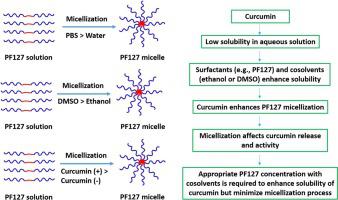Colloids and Surfaces B: Biointerfaces ( IF 5.4 ) Pub Date : 2020-07-08 , DOI: 10.1016/j.colsurfb.2020.111250 Raj Kumar Thapa 1 , Flavio Cazzador 2 , Krister Gjestvang Grønlien 1 , Hanne Hjorth Tønnesen 1

|
The drug solubilization capacity of poloxamers like Pluronic F127 (PF127, poloxamer 407) is dependent on the physical form of the polymer; i.e. the distribution between unimers, aggregates, and micelles. Further, the formation of micelles can alter the stability and pharmacological activity of a drug molecule. It is therefore important to understand how the micellization process is influenced by the addition of excipients and drug molecules. Curcumin is considered a photosensitizer in antimicrobial photodynamic therapy (aPDT). The aPDT effect is optimized at a poloxamer concentration just below the critical micellar concentration (CMC). We aimed to evaluate the effect of curcumin in the presence of 1% ethanol (EtOH) or dimethyl sulfoxide (DMSO) on PF127 micellization. These organic solvents are commonly used in topical preparations as a cosolvent or penetration enhancer (in the case of DMSO). The micellization process was investigated by UV–vis spectroscopy, dynamic light scattering (DLS), and differential scanning calorimetry (DSC). The micellization process of PF127 was slightly influenced by the addition of 1% EtOH or DMSO; however, the presence of 20 μM curcumin enhanced the effect. Micellization was favored in PBS compared to MilliQ water. Structures were formed between PF127 and curcumin at poloxamer concentrations ≥0.3 μM which facilitated solubilization of the photosensitizer. The optimal PF127 concentration required to solubilize 20 μM curcumin but avoid micellization was in the range 0.3 μM–0.04 mM in PBS in the presence of 1 % EtOH or DMSO. A careful consideration of the curcumin, cosolvents, and PF127 concentrations is required to enhance the curcumin solubility and prevent the PF127 micellization.
中文翻译:

姜黄素和共溶剂对水溶液中 Pluronic F127 胶束化的影响。
泊洛沙姆(如 Pluronic F127(PF127、泊洛沙姆 407))的药物增溶能力取决于聚合物的物理形式;即单体、聚集体和胶束之间的分布。此外,胶束的形成可以改变药物分子的稳定性和药理活性。因此,了解添加赋形剂和药物分子如何影响胶束化过程非常重要。姜黄素被认为是抗菌光动力疗法 (aPDT) 中的一种光敏剂。aPDT 效应在略低于临界胶束浓度 (CMC) 的泊洛沙姆浓度下得到优化。我们旨在评估姜黄素在 1% 乙醇 (EtOH) 或二甲亚砜 (DMSO) 存在下对 PF127 胶束化的影响。这些有机溶剂通常在局部制剂中用作助溶剂或渗透促进剂(在 DMSO 的情况下)。通过紫外-可见光谱、动态光散射 (DLS) 和差示扫描量热法 (DSC) 研究胶束化过程。PF127 的胶束化过程受 1% EtOH 或 DMSO 的影响较小;然而,20 μM 姜黄素的存在增强了效果。与 MilliQ 水相比,PBS 有利于胶束化。在泊洛沙姆浓度≥0.3 μM 时,PF127 和姜黄素之间形成了结构,这有助于光敏剂的溶解。在存在 1% EtOH 或 DMSO 的情况下,溶解 20 μM 姜黄素但避免胶束化所需的最佳 PF127 浓度在 PBS 中的范围为 0.3 μM–0.04 mM。仔细考虑姜黄素、助溶剂、











































 京公网安备 11010802027423号
京公网安备 11010802027423号